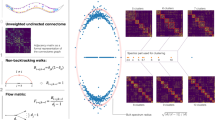Abstract
Caenorhabditis Elegans (C. Elegans) is a worm, which has had several studies to search its nerve paths. In a neuronal network simulation, it is util to know which is the first weight to assign in each link if it is not presented to determine other characteristics (e.g. distances by weights). Normally, the weight is a heuristic to solve a problem. There is a data set about connections of C. Elegans which is a result of other authors. The weights by the connection are not set in the data set. In this work, we use the data set to determine experimental weights for each connection with four cluster algorithms. The weights are to use in future work. To compare the algorithms, we created several models for each algorithm. We used metrics to evaluate the results for each model. A spectral clustering algorithm was chosen how the better algorithm to generate the weights.
Access this chapter
Tax calculation will be finalised at checkout
Purchases are for personal use only
Similar content being viewed by others
References
Abbas, O.A.: Comparisons between data clustering algorithms. Int. Arab J. Inf. Technol. (IAJIT) 5(3) (2008)
Bacik, K.A., Schaub, M.T., Beguerisse-Díaz, M., Billeh, Y.N., Barahona, M.: Flow-based network analysis of the Caenorhabditis Elegans connectome. PLoS Comput. Biol. 12(8), e1005055 (2016)
Bargmann, C.I., Horvitz, H.R.: Chemosensory neurons with overlapping functions direct chemotaxis to multiple chemicals in c. elegans. Neuron 7(5), 729–742 (1991)
Chen, L., Vogelstein, J.T., Lyzinski, V., Priebe, C.E.: A joint graph inference case study: the c. elegans chemical and electrical connectomes. In: Worm, p. e1142041. Taylor & Francis (2016)
Du, K.L.: Clustering: a neural network approach. Neural Netw. 23(1), 89–107 (2010)
Ester, M., Kriegel, H.P., Sander, J., Xu, X., et al.: A density-based algorithm for discovering clusters in large spatial databases with noise. In: KDD, pp. 226–231 (1996)
Florez, H., Cárdenas-Avendaño, A.: A computer-based approach to study the Gaussian moat problem. In: Florez, H., Misra, S. (eds.) ICAI 2020. CCIS, vol. 1277, pp. 481–492. Springer, Cham (2020). https://doi.org/10.1007/978-3-030-61702-8_33
Golbeck, J.: Analyzing the Social Web. Newnes (2013)
Halkidi, M., Vazirgiannis, M.: A density-based cluster validity approach using multi-representatives. Pattern Recogn. Lett. 29(6), 773–786 (2008)
Hernandez, J., Daza, K., Florez, H.: Alpha-beta vs scout algorithms for the Othello game. In: CEUR Workshops Proceedings, vol. 2846 (2019)
Kim, J., Leahy, W., Shlizerman, E.: Neural interactome: interactive simulation of a neuronal system. Front. Comput. Neurosci. 13, 8 (2019)
Li, S., et al.: A map of the interactome network of the metazoan C. elegans. Science 303(5657), 540–543 (2004)
McGinnis, W.D., Siu, C., Andre, S., Huang, H.: Category encoders: a Scikit-learn-contrib package of transformers for encoding categorical data. J. Open Sour. Softw. 3(21), 501 (2018)
Morales, A., Froese, T.: Unsupervised learning facilitates neural coordination across the functional clusters of the C. elegans connectome. Front. Robot. AI 7, 40 (2020)
Sanchez, D., Florez, H.: Improving game modeling for the Quoridor game state using graph databases. In: Rocha, Á., Guarda, T. (eds.) ICITS 2018. AISC, vol. 721, pp. 333–342. Springer, Cham (2018). https://doi.org/10.1007/978-3-319-73450-7_32
Towlson, E.K.: Caenorhabditis elegans and the network control framework–FAQs. Philos. Trans. R. Soc. B: Biol. Sci. 373(1758), 20170372 (2018)
Varshney, L.R., Chen, B.L., Paniagua, E., Hall, D.H., Chklovskii, D.B.: Structural properties of the Caenorhabditis elegans neuronal network. PLoS Comput. Biol. 7(2), e1001066 (2011)
Velosa, F., Florez, H.: Edge solution with machine learning and open data to interpret signs for people with visual disability. In: CEUR Workshop Proceedings, vol. 2714, pp. 15–26 (2020)
White, J.G., Southgate, E., Thomson, J.N., Brenner, S.: The structure of the nervous system of the nematode Caenorhabditis elegans. Philos. Trans. R. Soc. Lond. B Biol. Sci. 314(1165), 1–340 (1986)
White, S., Smyth, P.: A spectral clustering approach to finding communities in graphs. In: Proceedings of the 2005 SIAM International Conference on Data Mining, pp. 274–285. SIAM (2005)
Zhang, T., Ramakrishnan, R., Livny, M.: BIRCH: an efficient data clustering method for very large databases. ACM SIGMOD Rec. 25(2), 103–114 (1996)
Zhuzhunashvili, D., Knyazev, A.: Preconditioned spectral clustering for stochastic block partition streaming graph challenge (preliminary version at arxiv.). In: 2017 IEEE High Performance Extreme Computing Conference (HPEC), pp. 1–6. IEEE (2017)
Zuluaga, J.Y., Yepes-Calderon, F.: Tensor domain averaging in diffusion imaging of small animals to generate reliable tractography. ParadigmPlus 2(1), 1–19 (2021)
Author information
Authors and Affiliations
Corresponding author
Editor information
Editors and Affiliations
Rights and permissions
Copyright information
© 2021 Springer Nature Switzerland AG
About this paper
Cite this paper
Hernandez, J., Florez, H. (2021). An Experimental Comparison of Algorithms for Nodes Clustering in a Neural Network of Caenorhabditis Elegans. In: Gervasi, O., et al. Computational Science and Its Applications – ICCSA 2021. ICCSA 2021. Lecture Notes in Computer Science(), vol 12957. Springer, Cham. https://doi.org/10.1007/978-3-030-87013-3_25
Download citation
DOI: https://doi.org/10.1007/978-3-030-87013-3_25
Published:
Publisher Name: Springer, Cham
Print ISBN: 978-3-030-87012-6
Online ISBN: 978-3-030-87013-3
eBook Packages: Computer ScienceComputer Science (R0)



